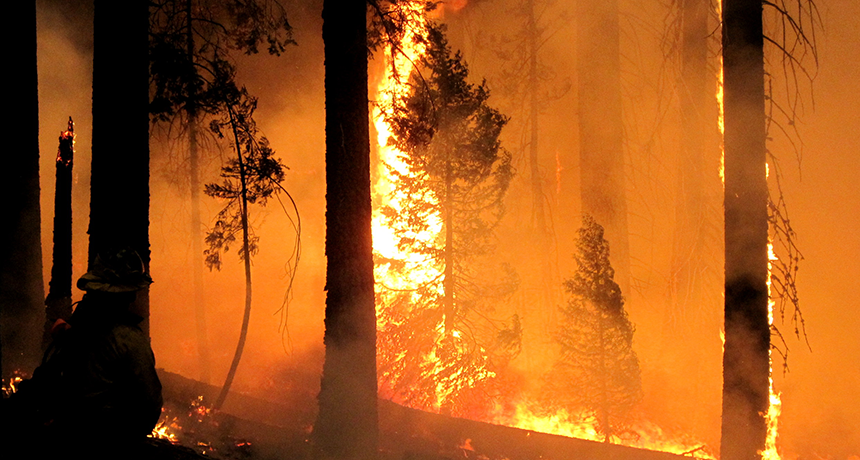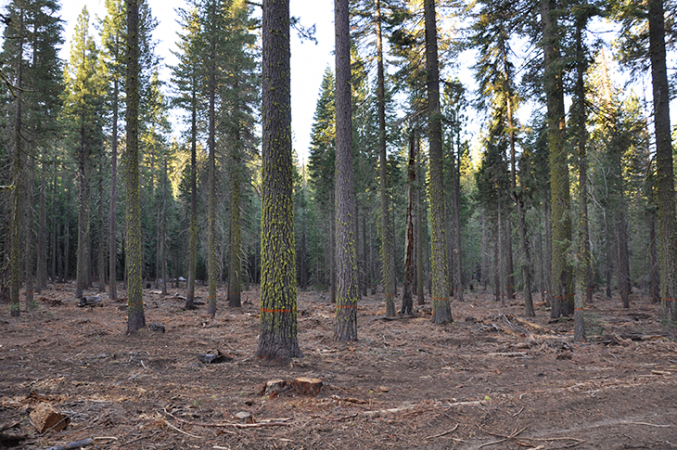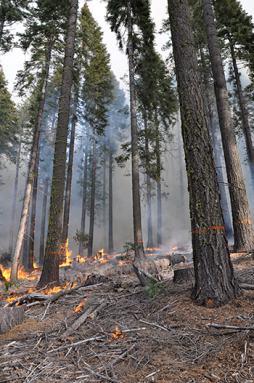Surprise! Fire can help some forests keep more of their water
Burning clears out vegetation that had been slurping precious groundwater

The 2013 Rim Fire, the largest Sierra Nevada fire to date, burned 1,040 square kilometers (400 square miles). Smaller, more frequent fires might have limited this damage and preserved water for surviving trees.
G. Dickman/NSF
Share this:
- Share via email (Opens in new window) Email
- Click to share on Facebook (Opens in new window) Facebook
- Click to share on X (Opens in new window) X
- Click to share on Pinterest (Opens in new window) Pinterest
- Click to share on Reddit (Opens in new window) Reddit
- Share to Google Classroom (Opens in new window) Google Classroom
- Click to print (Opens in new window) Print
In forests, abundant trees are good and fire is bad, right? Actually, the reverse can be true — especially in some regions of California’s Sierra Nevada Mountains. That conclusion comes from a new study.
Trees don’t use all the water they absorb. They release some into the air through tiny pores in their leaves. The process is known as evapotranspiration. It’s a big word for how plants shed excess moisture as water vapor. Scientists can measure this released vapor. In forests, they sometimes put sensors on tall towers to get closer to the leaves.
Jim Roche works for the U.S. National Park Service in California at Yosemite (Yo-SEM-ih-tee) National Park. As a hydrologist, he measures the movement of water (in its many forms) on or near Earth’s surface. He is interested in how fires affect water in forests.
Roche and two of his colleagues worked in two river basins in California. A river basin is all the land that supplies water to a stream or river. The scientists compared how fires decreased greenery — a measure of forest cover — in the basins of the Kings and the American rivers from 1990 to 2008. They used satellite images to monitor greenery there from the skies. Next, they calculated water-vapor release in the past based on modern data. Then they compared the water-vapor release from burned and unburned patches of forest during each of the 18 study years.
Evapotranspiration is measured as a depth, in millimeters. That depth is how deep the released moisture — if it were all liquid water — would have covered an area of land. Fires that reduced green cover by 40 to 50 percent saved the forest some 153 to 218 millimeters (6 to 8.6 inches) of water per hectare (almost 2.5 acres) of land, the team found. In burned areas of the American River basin, that added up to roughly 77 billion liters (17 billion gallons) of water per year not being lost to the air.
Without people to suppress them, wildfires usually occur in parts of this forest every 20 years or so. If the entire 5,310 square kilometer (2,050 square mile) American River basin had been allowed to go through that natural cycle, the water savings per year increases to roughly 773 billion liters (170 billion gallons).
“It’s not a one-time gift — that’s every year,” Roche says. The team published its findings April 6 in Ecohydrology.
Understanding the impacts

Wildfires that sweep through a forest every few decades clear out many of the young trees and underbrush that sprout in non-fire years. This leaves fewer plants to pull water from the soil. And that allows more water to filter into rivers and reservoirs downstream. There also will be more water available to the larger trees that survive the fires. With less competition from other plants, these trees can grow, strengthen and remain healthy.
Some forest managers actually start fires to burn off those thirsty understory trees and brush. These fires are known as “controlled burns.” Researchers choose where, when and how much forest to burn so that it can be done safely and in a way that will improve forest health. Similarly, some managers also selectively log trees and brush to clear out those that otherwise might fuel a later, runaway wildfire.
Such forest-control activities are costly. State and federal officials may try to save money by waiting to clear out brush. But dealing with drought and fighting uncontrolled wildfires is also important — and expensive. Roche’s study could help forest managers focus on the areas where they can have the biggest impact. These analyses might estimate how much water controlled burns or logging might preserve, notes Daniel Cadol. He is a hydrologist at the New Mexico Institute of Mining and Technology in Socorro.

But it isn’t yet clear how well Roche’s method will predict water savings in other places. Different ecosystems may use water differently, Cadol says. In very dry areas, plants will just slurp up any extra water. There will be no excess to flow into rivers and communities downstream.
“Here [in New Mexico,] we rarely see big water savings, even with aggressive thinning,” Cadol says. That’s because the surviving trees benefit from the preserved soil moisture to live healthier lives. “From a fire-prevention point of view,” he points out, “that’s great, since there’s less fuel and more [fire-] resistant trees.”
Controlled burns might offer other benefits, too.
Take the dry hills around Santa Fe, N.M. Here, controlled fire still can help — even if the water it saves doesn’t make it all the way into rivers and streams. Burning off shrubby undergrowth makes space between trees for grasses to emerge. Those grasses hold soil in place when rains do fall. Then moisture can soak into the ground instead of rushing off downhill. And this can prevent floods and mudslides.
Fire-thinned forests also may cope better with global warming. Trees use more water when temperatures are higher. So keeping forests thinned out means there will be more water around to slake their thirst when the region warms even more.







